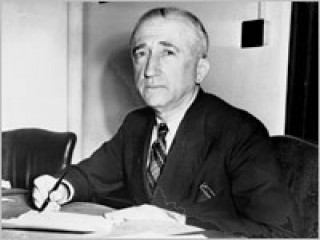
James F. Byrnes biography
Date of birth : 1879-05-02
Date of death : 1972-04-09
Birthplace : Charleston, S.C., United States
Nationality : American
Category : Politics
Last modified : 2011-07-14
Credited as : Politician and statesman, Governor of South Carolina,
James F. Byrnes was born to immigrant Irish parents in Charleston, S.C., on May 2, 1879. His early years were difficult, for his father died a few weeks before his birth. His mother, left with two young children and almost penniless, took up dressmaking to support her family. To help, James left school when he was 14 to work as an office boy in a local law firm. Taught shorthand by his mother, he won a competition and obtained a job as a stenographer in the Second Circuit Court of South Carolina in 1900. In his free time he studied law and 3 years later was admitted to the South Carolina bar.
Byrnes opened his own law office in Aiken. He found few paying clients, however, and continued in his job as a court reporter. He also bought the Aiken Journal and Review, but his career in journalism was brief. In 1908 he was elected a circuit solicitor (an office equivalent to that of a prosecuting or district attorney) and sold his interest in the newspaper to his partner. Two years later he was elected to his first term in Congress. Before entering public life, Byrnes had married Maude Busch of Aiken in May 1906.
In 1911 Byrnes entered the House of Representatives, remaining until 1925, serving on the House Committee on Roads, the Banking and Currency Committee, and the Appropriations Committee. These experiences, together with his personal qualities, contributed to his political success. Byrnes was a genial and charming person, with a sense of humor, who quickly mastered the game of politics. "The art of legislating," he later observed," is the art of intelligent compromise."
Defeated for the Senate in 1924, Byrnes was elected in 1930. A realistic politician, a southerner, and a loyal Democrat, he supported Franklin Roosevelt in the election of 1932 and was tapped as a "brain truster" for budgetary matters. Byrnes strongly promoted New Deal legislation in the Senate during Roosevelt's first term, but after 1937 he adopted a more conservative position. He loyally defended the President's foreign policy, however, especially in the extension of trade agreements and defense appropriations. In 1940 Roosevelt considered Byrnes for the vice-presidential nomination but decided in favor of Henry Wallace. Following his third-term reelection, the President appointed Byrnes associate justice to the Supreme Court (June 1941).
But World War II was at hand, and Byrnes was on the Supreme Court for only 16 months before Roosevelt made him director of the Office of Economic Mobilization and, in the next year, head of the six-man War Mobilization Board. Byrnes now had considerable authority in the management of domestic affairs, while Roosevelt concentrated on the military conduct of the war. Byrnes's administrative performance was so outstanding that he became popularly known as "Assistant President." Roosevelt again considered Byrnes as a vice-presidential candidate in 1944 but chose Harry S. Truman. Byrnes, however, accompanied Roosevelt to the Yalta Conference in February 1945, and his detailed shorthand notes proved to be very helpful to President Truman. Shortly after Roosevelt's death in 1945, Truman appointed Byrnes secretary of state, a post he held until January 1947.
Byrnes's tenure coincided with the collapse of the wartime cooperation with the Soviet Union and the onset of the cold war. As secretary of state, he tried unsuccessfully to reconcile the conflicting interests between the United States and the Soviet Union. To satisfy the Soviet Union's demand for security against Germany, he proposed a four-power treaty of alliance to keep Germany demilitarized for 25 years; but the Kremlin rejected this offer. His effort to resolve the atomic energy issue between the two powers in 1945— he suggested the exchange of atomic information without absolute and effective agreement on inspection and control—met with opposition in Congress. Although unable to obtain solutions on either issue, Byrnes managed in 1946 to work out compromise peace treaties with the Soviet Union for Italy, Romania, Bulgaria, Hungary, and Finland. On Sept. 6, 1946, he delivered his famous Stuttgart speech, which called for the creation of an autonomous democratic German state. Increasingly, Byrnes adopted a tough posture toward the Soviet Union, but disagreements with President Truman led to his resignation on Jan. 10, 1947.
Following his departure from the Cabinet, Byrnes became associated with a Washington law firm, but in 1950 he ran for governor of South Carolina and was elected by an overwhelming majority. As governor, he fulfilled his campaign pledge to suppress the Ku Klux Klan in the state, but he resisted the efforts of the Federal government to desegregate public schools. Byrnes retired in 1955 and died on April 9, 1972, in Columbia, S.C.
There are no biographies of Byrnes. The most important sources on his life are his two memoirs, Speaking Frankly (1947) and All in One Lifetime (1958). The best account of Byrnes's tenure as secretary of state is the chapter by Richard D. Burns in Norman A. Graebner, ed., An Uncertain Tradition: American Secretaries of State in the Twentieth Century (1961). A brief, impressionistic vignette is in Raymond Moley, 27 Masters of Politics: In a Personal Perspective (1949).
















